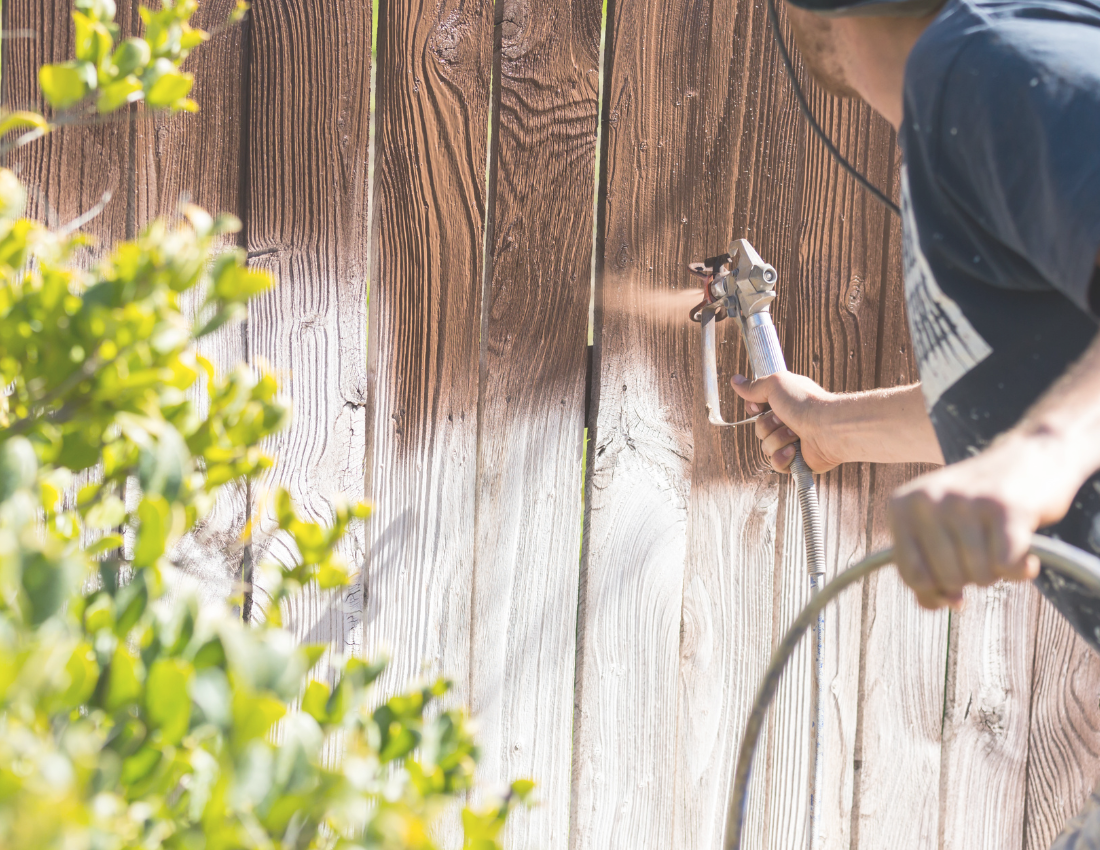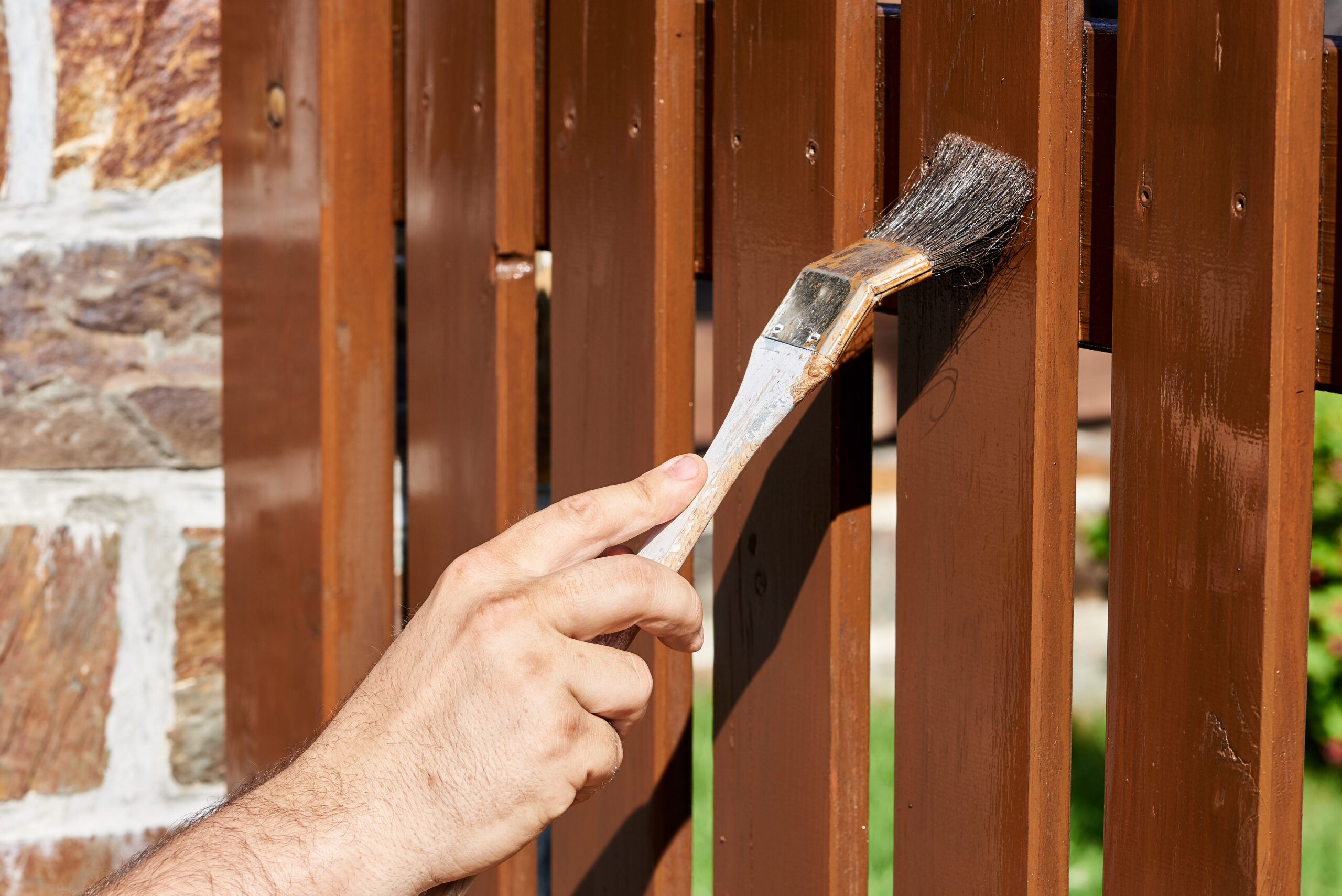If you’ve ever stood in your backyard staring at a weathered fence and wondered, “should I paint or stain my fence?” — you’re not the only one.
Fences in Fuquay Varina, NC face just about everything: hot summers, heavy rain, and plenty of humidity. All that exposure means your fence needs protection, and the finish you choose will decide how it looks and how long it lasts.
Paint and stain both have their advantages. Paint covers your fence in a solid coat of color, while stain sinks deep into the wood grain and highlights its natural texture. One demands more prep, the other fades more gracefully.
So how do you know which option is right for your wood fence? Let’s break it down and help you pick the finish that works best for your fence, deck, and outdoor spaces.
Key Takeaways:
- Stain highlights natural wood grain and fades more gracefully than paint.
- Paint provides endless color choices but needs more prep and maintenance.
- Fuquay Varina’s humid climate makes regular fence care especially important.
- Cost differences even out once you factor in longevity and reapplication needs.
- Professional fence and deck painters in Fuquay Varina, NC ensure lasting results.

Paint or Stain My Fence – What Makes the Biggest Difference?
Both paint and stain serve the same goal: to protect wood from moisture, mold, and UV damage while also improving its appearance. But they do it in different ways. Paint forms a solid coat that covers the wood grain, while stain penetrates into the fibers, highlighting the natural look of the lumber.
If you’ve been considering whether to paint or stain your fence, it’s worth thinking about the type of exterior wood you have, the climate, and the amount of maintenance you’re comfortable with. A fresh coat not only improves aesthetics, but it can also extend the longevity of your fence and keep it from rotting prematurely.
Durability and Longevity
In a place like Fuquay Varina, where fences deal with humidity and heavy rainfall, durability is key. Stain usually lasts three to four years before reapplication, while paint can last up to six years with the right primer and paint brand.
Here’s the catch:
- Stain tends to fade gradually, so you’ll notice the color lightening over time.
- Paint often peels, cracks, or forms blisters when exposed to too much water or if the wood wasn’t properly prepped.
The trade-off is simple. If you want something that looks “clean and fresh” for longer, paint does the job. But if you’d rather deal with less prep when it’s time for another coat, stain makes things easier. For extra context on prep, check out our post on primer coats before painting fences and decks.
Appearance and Color Options
When people ask “should I paint or stain my fence,” color is usually the first thing on their mind. Paint gives you endless choices. Whether you’re after a crisp white picket fence or a bold accent color, paint lets you match your fence with your house trim, deck, or even outdoor furniture.
Stain, on the other hand, enhances the natural wood grain. You can pick from light tints that highlight the raw look of cedar or darker shades that resemble a rich mahogany. Solid stains even mimic paint while still penetrating into the wood for better protection.
If you want variety, paint is the winner. But if you love the natural look of wood, stain will highlight the character of the material without covering it. For fences that tie into backyard features like decks or picket fences, stain often creates a more natural flow.
Application and Maintenance
Maintenance is one of the biggest deciding factors for homeowners in Fuquay Varina.
- Stain: Can be applied with a sprayer or brush, and prep is usually as simple as pressure washing the fence and letting it dry. Stain doesn’t peel or crack, so when it fades, you can apply a fresh coat without much sanding.
- Paint: Requires more prep. Old paint must be scraped, and rough surfaces often need sandpaper or patching with a putty knife before applying a new coat. But with a good primer and high-quality paint, it can protect against moisture longer than stain.
For those comparing methods, our write-up on roller painting vs spray painting offers some useful insight into which technique gives better coverage depending on your fence’s condition.
Cost Comparison
A lot of people assume paint is cheaper than stain, but the truth is, the cost balances out over time. Paint typically requires primer, more product per square foot, and often a full gallon or more for decent coverage. Stain costs more upfront, but you’ll use less of it and avoid the cost of primers.
Also, consider the brand you choose. Popular names like Behr or other professional-grade lines offer both paint and stain in formulas that are designed to resist mold, mildew, and climate wear.
When it comes to the actual fence installation or refinishing, cost should be weighed with how long you want the finish to last and how much maintenance you’re willing to put into it.
How Climate Affects Your Fence
In North Carolina, humidity and sudden rain showers create conditions where mold and mildew thrive. Both paint and stain protect wood from moisture, but they do it differently. Paint forms a barrier, while stain soaks in and creates a shield inside the fibers.
If your fence is exposed to constant rain or sits in shaded areas where moisture lingers, you’ll want to be proactive with maintenance. Stain can be more forgiving since it fades instead of peeling, but paint creates a thicker coat of waterproofing.
For a deeper look at protection types, check out our post about exterior paint types, which breaks down how each formula responds to different weather conditions.

Wood Types and Special Cases
Not every type of lumber reacts the same way.
- Cedar fences don’t always hold paint well. The oils in the wood can cause adhesion issues, and paint may shorten the wood’s natural lifespan.
- Pressure-treated lumber can be painted or stained, but it must dry thoroughly first, or else the finish won’t hold.
- Rough-sawn fences or rustic styles usually do better with an oil-based wood stain or solvent-based sealant to maintain their natural texture.
If you have an older wood fence that was previously painted, switching to stain can be tricky. You’ll need heavy prep, and in most cases, sanding or stripping is required before applying stain.
Professional Fence Painting and Staining
If you’re weighing the decision of “should I paint or stain my fence,” the best choice depends on your fence’s condition, the look you want, and how much upkeep you’re okay with. Either option will improve the aesthetics, protect against water, and help extend the longevity of your fences and decks.
For a closer breakdown of why a treated fence lasts longer and looks better, take a look at our article on the benefits of painting a fence.
Closing Thoughts: Choosing the Best Finish for Your Fence
Deciding between paint and stain isn’t about which is better overall. It’s about which fits your style, maintenance comfort, and the climate in Fuquay Varina, NC. Stain highlights natural wood grain and requires less prep work when reapplying, while paint offers endless colour options and stronger surface protection. Both protect your investment against rain, mildew, mold, and everyday wear.
At Alvarez Painting, our professional deck painters in Fuquay Varina, NC have years of experience working with fences, decks, and all types of exterior wood. We help homeowners choose the right product, apply it with the correct technique, and deliver results that last.
Ready to refresh your fence or deck? Call Alvarez Painting today for a FREE estimate in Fuquay Varina, Morrisville, Wake Forest, Chapel Hill, NC and the surrounding areas. You can reach us at 919-444-8997.


